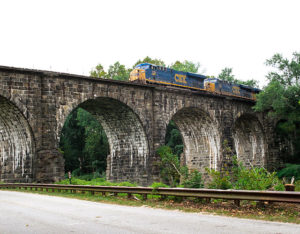Ohio’s Rickenbacker terminal part of NS’s improved rail route
Written by jroodTrains are nothing new in central Ohio, but they are poised to play am increasing role in the economy, the Columbus Dispatch reports. Beginning Sept. 9, Norfolk Southern will use the revamped Heartland Corridor line, taking advantage of what the company calls the "single biggest railroad engineering project in modern history." It included enlarging tunnels through mountains and raising bridges in other places.
The $191-million project
will expand the possibilities for shipping from central Ohio to points east and
south, as well as to the growing port of Norfolk, Va. The corridor allows
trains to travel between the port of Norfolk, Va., and Columbus in 25 hours with
shipping containers stacked two high.
Norfolk Southern’s point of
connection in Columbus is the two-year-old, $63-million Rickenbacker intermodal
terminal, which serves as a point where goods can be transferred from trains to
trucks or vice versa. Like the Heartland Corridor, it was paid for with a
combination of public and private funds.
The corridor will serve the
growing demand for goods to be imported and exported through East Coast ports,
said Jeff Heller, group vice president of international intermodal for Norfolk
Southern.
"In the past 10 years,
more and more cargo wants to come in from the East Coast rather than the West
Coast, which has long had good connections to Columbus," Heller said. He
said the reasons for this include the proximity of the East Coast to more of the
U.S. population and the migration of overseas manufacturing to India and away
from Asia.
Other reasons include
congestion and labor issues with West Coast ports, said Michael Knemeyer,
associate professor of logistics at Ohio State University’s Fisher College of
Business.
The project is an
investment in the future and one that local development officials hope will be
an engine of economic growth for decades to come. In addition to serving local
companies such as Limited Brands, Big Lots, Cardinal Health and Honda, whose
businesses are dependent on efficient transportation, ease of transport is also
a big factor in attracting jobs and businesses, said Steve Tugend, vice president
of government relations for the Columbus Chamber.
"Access to markets is
one of the key factors in where a company will locate," Tugend said. He
emphasized that goods will flow both ways – with local companies exporting as
well as importing – with the hope that the increased activity will help create
well-paying jobs and attract logistics companies that manage the flow of goods
and increasingly use high-tech methods to perform that work.
The Columbus Regional
Airport Authority in particular stands to benefit, as the largest single
landholder in the Rickenbacker area. It contributed the land for the
Rickenbacker intermodal terminal and plans eventually to turn the property over
to Norfolk Southern in a land swap.
At present, cargo shipping
remains significantly down from pre-recession levels, but railroad executives
say they’re confident demand will come back.
"Two years ago, we
were at capacity every day," said Chris Jeselnik, district manager for Norfolk
Southern. "When (demand) comes back, it’ll be easy to meet it now."
The Heartland Corridor is
part of an overall trend toward increasing freight capacity on the nation’s
rail systems. Norfolk Southern has two other similar projects in the works in
the South and Midwest, valued at about $4.8 billion.
Ohio is also part of
expansion plans by CSX Transportation, which still is seeking to piece together
the necessary funds to start work on its National Gateway project connecting
several Middle Atlantic ports to the Midwest with double-stack capability by
2015.
"Traditionally, rail
companies were late to make these kinds of investments," said OSU’s
Knemeyer. "But with the increased focus on doing things in a more
sustainable way combined with the economies of shipping by rail, that’s driving
demand for rail transportation as an important part of intermodal
shipping.
"We may be a little
slower," Heller said, "but we can factor that into what we charge.
Rail shipping satisfies the needs for efficiency and environmental
friendliness. Plus," Heller added, "we’re not building new highways
anymore."





